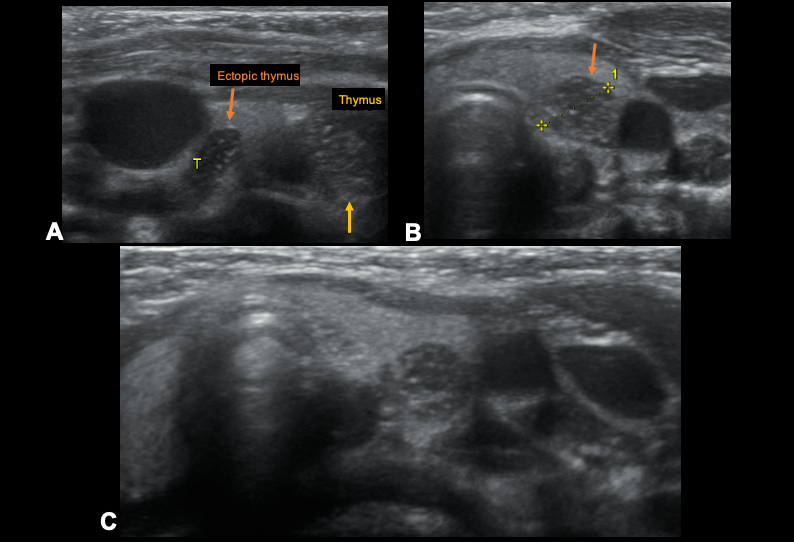本帖最后由 hyc3140 于 2021-6-1 10:50 编辑
胸腺病变:图文综述 Thymic lesions: a pictorial review 复习正常胸腺解剖。 探讨胸腺良、恶性及罕见病变在不同诊断技术中的影像学表现。 回顾可以诊断多发性胸腺病变的影像学参数。 展示鉴别诊断。
To review the normal thymic anatomy. To describe the imaging features of benign, malignant, and rare thymic lesions in the different diagnostic techniques. To review the imaging parameters that allow the diagnosis of multiple thymic lesions. Expose the differential diagnosis.
背景 胸腺是免疫系统的淋巴器官,被认为是T淋巴细胞成熟的主要部位[1,2]。它从第3和第4鳃袋两侧出现,在妊娠第6周开始发育[1-3]。随后,组织向纵隔和尾部迁移到前纵隔。随后,淋巴细胞从肝脏和骨髓迁移到胸腺,导致腺体分叶状,随后,胸腺分化为皮质和髓质[2]。由于迁移,异位胸腺组织或病变可能发生在沿着这一束的胸腺导管(图1)。
胸腺在青春期达到最大重量。成年后,上皮细胞被脂肪组织取代[1]。
识别正常胸腺并将其与良性或恶性的病理状态区分开来是至关重要的。此外,由于它位于前纵隔,了解其他前纵隔肿块(例如脂肪瘤、脂肪肉瘤、淋巴管瘤、异位甲状腺、甲状旁腺病变和结节病)的鉴别诊断也很重要[1]。
Background The thymus is a lymphoid organ of the immune system, and it is considered the primary site of T-lymphocyte maturation [1,2]. It emerges bilaterally from the 3rd and 4th branchial pouches, and the development begins in the 6th gestational week [1-3]. Later, the tissue migrates medially and caudally to the anterior mediastinum. Following that, there is a migration of the lymphoid cells from the liver and bone marrow to the thymus, leading to lobulation of the gland, and subsequently, the thymus differentiates into a cortex and medulla [2]. Due to the migration, ectopic thymic tissue or lesions may occur anyway along this tract of the thymopharyngeal duct (figure 1).
The thymus reaches the maximum weight in puberty. At adult age, the epithelial cells are replaced by adipose tissue [1].
It is crucial to recognize the normal thymus and distinguish it from pathological conditions, either benign or malignant. Also, since it is located at the anterior mediastinum it is important to understand the differential diagnosis of other anterior mediastinal masses (ex: lipoma, liposarcoma, lymphangioma, ectopic thyroid, parathyroid lesions, and sarcoidosis) [1].

图1:3岁患者颈部超声显示甲状腺左叶异位胸腺。低回声结节伴细的高回声斑点,显示与胸腺相同的回声结构,与异位胸腺相容。异位胸腺(橙色箭头)。胸腺(黄色箭头)。
Fig 1: Cervical ultrasound of a 3-year-old patient showing an ectopic thymus in the left lobe of the thyroid. Hypoechogenic nodule with fine hyperechogenic speckles demonstrating an echo-structure identical to the thymus, compatible with an ectopic thymus. Ectopic thymus (orange arrow). Thymus (yellow arrow).
1.正常解剖和组织学 正常胸腺通常位于前纵隔。在计算机断层扫描(CT)中,它通常被视为一个双叶三角形结构,婴儿较大,但成年后逐渐退化(图2)[1,4]。胸腺覆盖心包、主动脉弓、左无名静脉和气管[4]。据描述,与女性相比,年轻成年男性的脂肪萎缩发生得更快[5]。 组织学上,胸腺组织成多个小叶,排列成一个内髓质,内髓质含有成熟的淋巴细胞和旋涡状的梭形上皮细胞,这些细胞形成具有角化核心的Hassall小体;外皮质由未成熟的T淋巴细胞和胸腺上皮细胞组成[2]。 图2:年轻患者的平扫CT,显示胸腺的正常形态,本例为箭头形状(B)。 Fig 2: Non-contrast CT in a young patient, showing the normal configuration of the thymus, in this case with an arrow-head shape (B).
1. NORMAL ANATOMY AND HISTOLOGY The normal thymus is normally located in the anterior mediastinum. At computed tomography (CT) it is usually visualized as a bi-lobed triangular structure, that is larger in infants but gradually involutes in adulthood (figure 2) [1,4]. The thymus overlies the pericardium, aortic arch, left innominate vein, and trachea [4]. It has been described that fatty atrophy occurs more rapidly in young adult men compared to women [5].
Histologically, the thymus is organized in multiple lobules arranged into an inner medulla which contains mature lymphocytes and whorls of spindle-shaped epithelial cells, which form Hassall corpuscles with keratinized cores; and an outer cortex which is composed of immature T-lymphocytes and thymic epithelial cells [2]. |